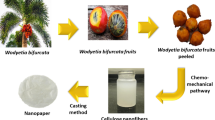Abstract
In order to enlarge the utilization field of wood and decrease the costs of carbon fibers, carbon fiber precursors from liquefied wood were prepared by soaking liquefied wood in a solution containing hydrochloric acid and formaldehyde, after melt-spinning by adding hexamethylenetetramine. The microstructure evolution of the precursor during carbonization was studied by FTIR, X-ray analysis and Raman spectroscopy. The results show that precursors from liquefied wood above 400°C had diffraction peaks corresponding to the (100) crystal plane. When the carbonization temperature reached 500°C, Raman spectroscopy showed the D peak at wave number of 1360 cm−1 and the G peak at 1595 cm−1. By increasing the carbonization temperature, the microstructure of the precursors became more ordered. Although the structure of the precursor changed at 500 and 800°C, the peaks at 1632 and 1454 cm−1 corresponding to the characteristic vibrations of aromatic rings, remained during carbonization. This implies that the precursor from liquefied wood cannot be easily formed into graphite.
Similar content being viewed by others
References
Alma M H, Yoshioka M, Yao Y, Shiraishi M. 1995a. Preparation and characterization of the phenolated wood using hydrochloric acid (HCl) as a catalyst. Wood Sci Technol, 30(1): 39–47
Alma M H, Yoshioka M, Yao Y, Shiraishi N. 1995b. Some characterizations of hydrochloric acid catalyzed phenolated wood-based materials. Mokuzai Gakkaishi, 41(8): 741–748
Blumberg H, Hillermerier K, Scholten E. 2000. Carbon fiber status and development. Chem Fiber Int, 50(2): 157–161
Byme C E, Nagle D C. 1997. Carbonization of wood for advanced materials applications. Carbon, 35(2): 259–266
Han S P, Xu L H, Cao W Y, Yao H. 2005. X-ray diffraction studies on crystalline structure of PAN precursors. J Beijing Univ Chem Technol, 32(2): 63–67 (in Chinese with English abstract)
Huang B, Chen X R, Jiang M S, Tang X P, Gao S Y. 2006. Effect of carbonization temperature on microporous structure of charcoal from Chinese Fir wood. Chem Ind Forest Prod, 26(1): 70–74 (in Chinese with English abstract)
Jiang Z H, Zhang D S, Fei B H, Yue Y D, Chen X H. 2004. Effects of carbonization temperature on the microstructure and electrical conductivity of bamboo charcoal. New Carbon Mater, 19(4): 249–253 (in Chinese with English abstract)
Kadla J F, Kubo S, Venditti R A, Gilbert R D, Compere A L, Griffith W. 2002. Lignin-based carbon fibers for composite fiber applications. Carbon, 40(15): 2913–2920
Kercher A K, Nagle D C. 2003. Microstructural evolution during charcoal carbonization by X-ray diffraction analysis. Carbon, 41(1): 15–27
Kubo S, Uraki Y, Sano Y. 1998. Preparation of carbon fibers from softwood lignin by atmospheric acetic acid pulping. Carbon, 36(8): 1119–1124
Liu C L, Guo Q G, Shi J L, Liu L. 2004. Microstructure evolution in preparation of carbon fibers from phenolic resin. New Carbon Mater, 19(2): 124–128 (in Chinese with English abstract)
Liu Q F, Lv Y G, Yang Y G, He F, Ling L C. 2005. Study on the pyrolysis of wood-derived rayon fiber by thermogravimetry-mass spectrometry. J Mol Struct, 733(1): 193–202
Ma X J, Zhao G J. 2008a. Structure and performance of spinning solution prepared form liquefied wood in phenol. Wood Fiber Sci, 40(3): 470–475
Ma X J, Zhao G J. 2008b. Structure and performance of fibers prepared from liquefied wood in phenol. Fiber Polym, 9(4): 405–409
Melanitis N, Tetlow P L, Galiotis C. 1996. Characterization of PAN-based carbon fibers with laser Raman spectroscopy. J Mater Sci, 31(4): 851–860
Sudo K, Shimizu K. 1992. A new carbon fiber from lignin. J Appl Polym Sci, 42(1): 127–134
Tsujimoto N, Naohjik O. 1985. Study on wood-phenol resin fiber. International Symposium on Wood and Pulping Chemistry, 19–20
Tu J H, Zhang L B, Peng J H, Pu J Z, Zhang S M. 2006. Structure evolution of woodceramics by X-ray diffraction and Raman Spectroscopy. J Inorg Mater, 21(4): 986–992 (in Chinese with English abstract)
Varshavskii V Y. 1994. Basic characteristic of structure formation in fabrication of carbon fibers from different raw material. Fiber Chem, 26(2): 79–85
Wang J G, Guo Q G, Liu L, Song J R. 2000. IR analysis of pyrolysis process of phenol formaldehyde resin mixed with white carbon black and B4C particles. Mater Sci Eng, 71(3): 3–76 (in Chinese with English abstract)
Wang S J. 2001. Structural group variety of organic macromolecule resin in carbonization process. J China Univ Petrol, 25(3): 5–48 (in Chinese with English abstract)
Author information
Authors and Affiliations
Corresponding author
Rights and permissions
About this article
Cite this article
Ma, Xj., Zhao, Gj. Effects of carbonization temperatures on microstructure of carbon fiber precursors prepared from liquefied wood. For. Stud. China 11, 238–242 (2009). https://doi.org/10.1007/s11632-009-0041-2
Received:
Accepted:
Published:
Issue Date:
DOI: https://doi.org/10.1007/s11632-009-0041-2




